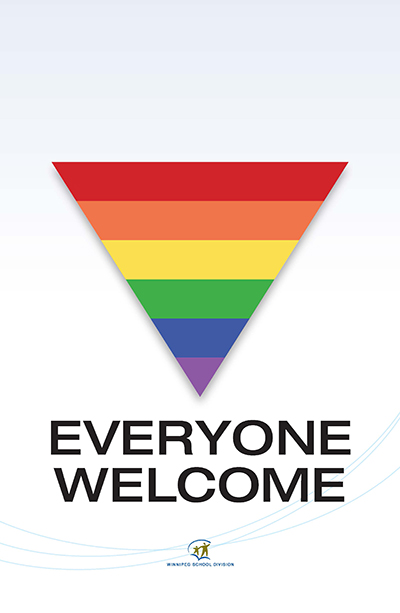Everyone Welcome
November 17, 2016
Winnipeg School Division staff, parents/guardians, students and community are committed to promoting the development of actions and attitudes that create a safe and caring learning environment. Inclusive policies and nurturing practices help to build a learning environment in which our most vulnerable students feel safe and valued, reducing the risk of self-harm and suicide. Studies show that creating a supportive environment for LGBTTQ students improves educational outcomes for all students, not just those who identify as LGBTTQ.
In WSD, family diversity is considered in every facet of the school community. From the first registration forms, to our ongoing communication with families, schools signal acknowledgement and welcome. In this inclusive environment, diverse families are normalized and children aren’t singled out or bullied because their family is “different.”
To help our students at all ages understand they are part of our inclusive environment, every school and building within WSD prominently displays Everyone Welcome posters. It is important to promote inclusivity at all grade levels, as students develop and form attitudes toward the world and each other.
 | The Everyone Welcome poster shown here is displayed at the entrance of all Winnipeg School Division schools and buildings. The creation of the poster was influenced by two of the most recognized international human rights symbols – the LGBTTQ pink triangle and the rainbow flag. The pink triangle was employed by the Nazis in World War II to identify homosexuals in concentration camps. The icon was reclaimed for the community as a symbol of empowerment and remembrance to those who suffered. The rainbow flag was inspired by the Flag of the Races which had five stripes, each representing the colours of human kind. The six colours of the rainbow flag also stands as a symbol of pride, diversity and unity of the LGBTTQ community: red for life, orange for healing, yellow for sun, green for nurture, blue for harmony and purple for spirit. These two symbols have been adapted by WSD into an inverted rainbow triangle and are used across the division in the Everyone Welcome poster to signify safe, inclusive and supportive spaces. |
Resources
- LGBTTQ Definitions
- Community Resources and Supports
- Safe Schools
- WSD Inclusion Across the Rainbow fact sheet
- Policy IGAAB (Safe and Caring - Trans and Gender Diverse Staff and Students)
- Policy IGAB (Diversity and Equity Education)
- 20/20 Barbara Walters interview with Jazz Jennings
- 10 things to know about transgender people – Jazz Jennings
- FAQ Safe and Caring Policy
- One Team – Promoting LGBTQ inclusion and respect in schools and sport
- MASS Fall Journal 2016

